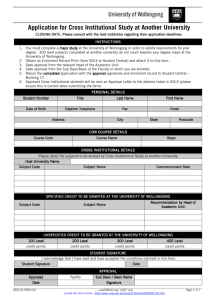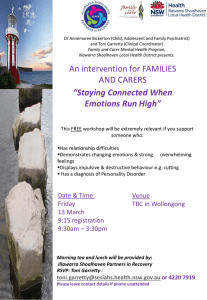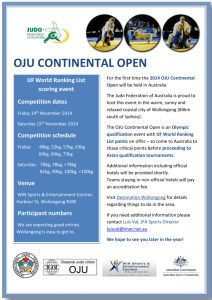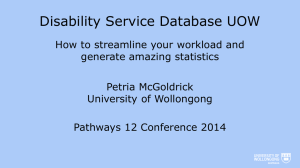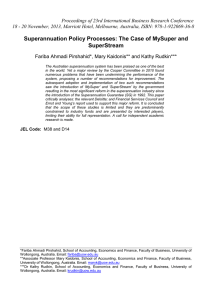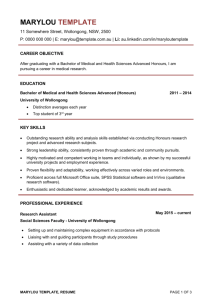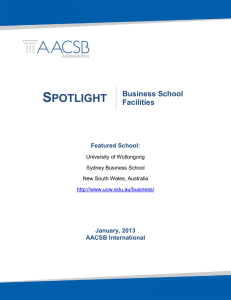Developing new drugs and treatments
advertisement
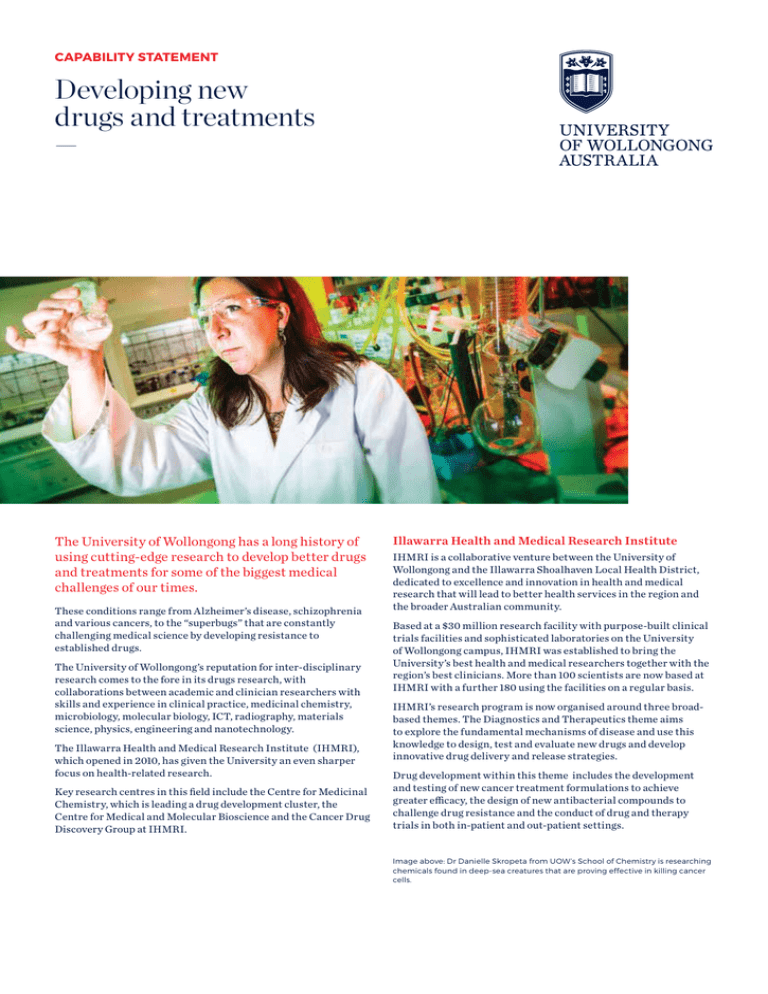
CAPABILITY STATEMENT Developing new drugs and treatments — The University of Wollongong has a long history of using cutting-edge research to develop better drugs and treatments for some of the biggest medical challenges of our times. These conditions range from Alzheimer’s disease, schizophrenia and various cancers, to the “superbugs” that are constantly challenging medical science by developing resistance to established drugs. The University of Wollongong’s reputation for inter-disciplinary research comes to the fore in its drugs research, with collaborations between academic and clinician researchers with skills and experience in clinical practice, medicinal chemistry, microbiology, molecular biology, ICT, radiography, materials science, physics, engineering and nanotechnology. The Illawarra Health and Medical Research Institute (IHMRI), which opened in 2010, has given the University an even sharper focus on health-related research. Key research centres in this field include the Centre for Medicinal Chemistry, which is leading a drug development cluster, the Centre for Medical and Molecular Bioscience and the Cancer Drug Discovery Group at IHMRI. Illawarra Health and Medical Research Institute IHMRI is a collaborative venture between the University of Wollongong and the Illawarra Shoalhaven Local Health District, dedicated to excellence and innovation in health and medical research that will lead to better health services in the region and the broader Australian community. Based at a $30 million research facility with purpose-built clinical trials facilities and sophisticated laboratories on the University of Wollongong campus, IHMRI was established to bring the University’s best health and medical researchers together with the region’s best clinicians. More than 100 scientists are now based at IHMRI with a further 180 using the facilities on a regular basis. IHMRI’s research program is now organised around three broadbased themes. The Diagnostics and Therapeutics theme aims to explore the fundamental mechanisms of disease and use this knowledge to design, test and evaluate new drugs and develop innovative drug delivery and release strategies. Drug development within this theme includes the development and testing of new cancer treatment formulations to achieve greater efficacy, the design of new antibacterial compounds to challenge drug resistance and the conduct of drug and therapy trials in both in-patient and out-patient settings. Image above: Dr Danielle Skropeta from UOW’s School of Chemistry is researching chemicals found in deep-sea creatures that are proving effective in killing cancer cells. CAPABILITY STATEMENT Developing new drugs and treatments Centre for Medical and Molecular Bioscience Case study: Developing intelligent drugs CMMB brings together a multidisciplinary team of chemists and biologists from the University of Wollongong’s School of Chemistry and School of Biological Sciences with a common interest in the molecular basis of disease and disease prevention. a University of Wollongong research program is developing a safer, more effective way to treat some of the most stubborn types of cancer. CMMB’s translational programs are aimed at developing new drug leads to more effectively tackle diseases associated with ageing and to address problems of cancer and drug resistance in infectious disease. Researchers with CMMB also work to expand understanding of molecular origins and mechanisms of disease to develop novel, potent pharmaceutical agents. Centre for Translational Neuroscience CTN’s researchers are working to find the means to prevent and treat schizophrenia, obesity and obesity-related colon cancer. Their approach is to study the pathological mechanisms of the diseases using human brain tissue, animal models and cell culture. New findings are then translated into novel pharmacological and dietary interventions for human diseases. Cancer drug discovery group Researchers from the Centre for Medicinal and Molecular Bioscience and oncologists from the Illawarra Cancer Care Centre within the Illawarra Shoalhaven Local Health District and private cancer clinics are involved in multi-disciplinary work to understand the biological processes underlying the disease, increase efficacy and reduce side effects of current drugs, find new targets for drugs, design new formulations and explore new drug delivery methods. The National Health and Medical Research Centre-funded project, which is being led by biophysicist Dr Moeava Tehei at IHMRI and the University’s School of Physics, aims to develop intelligent drugs that attach to malignant tumours like magnets. These powerful, next-generation chemotherapy drugs will seek out cancerous cells, allowing physicians to see exactly where tumours lie. Nano-particles inside the drugs then switch on upon contact with X-ray radiation beams. Dr Tehei, who leads the Targeted Nano-Therapies Research Group at the University of Wollongong, said this new method, which can diagnose, deliver targeted therapy and monitor the response to therapy all at the same time, would reduce the amount of radiation needed to kill cancer cells. The researchers are initially focusing on cancers that do not respond to traditional radiotherapy techniques, such as certain brain tumours, but hope the therapy can be adapted for several different cancers, including breast and prostate cancers. This collaborative project brings together researchers from the University’s Institute for Superconducting and Electronic Materials, Centre for Medical Radiation Physics, Centre for Medical and Molecular Bioscience and the Prince of Wales Hospital. Research includes drug design, synthetic organic and medicinal chemistry, radio-imaging, tumour cell biology and pre-clinical assessment to identify and validate new and/or improved classes of chemotherapeutics and diagnostics for cancer. Dr Moeava Tehei (left) with Master of Science student Lee Taylor and PhD student Kathrin Bogusz. Contact: Judy Raper Deputy Vice-Chancellor (Research and Innovation) University of Wollongong Ph: +61 2 4221 3915 E: judy_raper@uow.edu.au uow.edu.au The University of Wollongong attempts to ensure the information contained in this publication is correct at the time of production (March 2016); however, sections may be amended without notice by the University in response to changing circumstances or for any other reason. Check with the University for any updated information. UNIVERSITY OF WOLLONGONG CRICOS: 00102E
